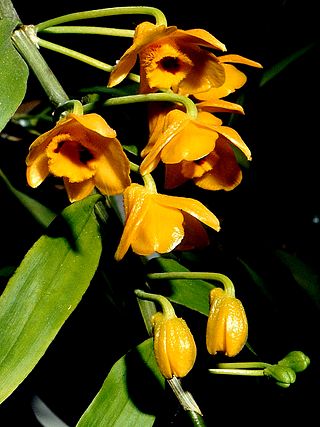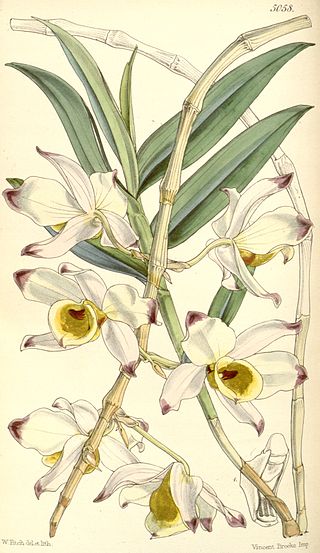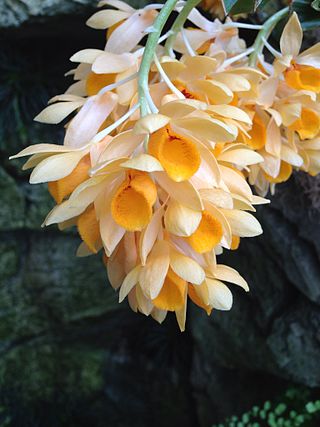
Yunnan, is a landlocked province in Southwest China. The province spans approximately 394,000 km2 (152,000 sq mi) and has a population of 48.3 million. The capital of the province is Kunming. The province borders the Chinese provinces of Guizhou, Sichuan, autonomous regions of Guangxi, and Tibet as well as Southeast Asian countries: Vietnam, Laos, and Myanmar. Yunnan is China's fourth least developed province based on disposable income per capita in 2014.

Dendrobium is a genus of mostly epiphytic and lithophytic orchids in the family Orchidaceae. It is a very large genus, containing more than 1,800 species that are found in diverse habitats throughout much of south, east and southeast Asia, including China, Japan, India, the Philippines, Indonesia, Australia, New Guinea, Vietnam and many of the islands of the Pacific. Orchids in this genus have roots that creep over the surface of trees or rocks, rarely having their roots in soil. Up to six leaves develop in a tuft at the tip of a shoot and from one to a large number of flowers are arranged along an unbranched flowering stem. Several attempts have been made to separate Dendrobium into smaller genera, but most have not been accepted by the World Checklist of Selected Plant Families.

Camellia sinensis is a species of evergreen shrub or small tree in the flowering plant family Theaceae. Its leaves, leaf buds, and stems can be used to produce tea. Common names include tea plant, tea shrub, and tea tree.

Paris is a genus of flowering plants described by Linnaeus in 1753. It is widespread across Europe and Asia, with a center of diversity in China.

The Yunnan nuthatch is a bird species in the nuthatch family Sittidae. It was first described by William Robert Ogilvie-Grant in 1900 based on a male holotype. It is a small nuthatch, measuring 12 centimetres (4.7 in) in length on average and weighs between 7.5 and 13 grams. The grey-blue upperparts contrast with the light, smooth, buffy lowerparts. It has a fine white eyebrow above a black eyestripe, which is distinct when the plumage is fresh, and exhibits a small degree of sexual dimorphism. A noisy bird, it produces simple, nasal sounds, sometimes in repetitive series.

The black-and-white snub-nosed monkey, also known as the Yunnan snub-nosed monkey, is a large black and white primate that lives only in the southern Chinese province of Yunnan, where it is known to the locals as the Yunnan golden hair monkey and the black-and-white snub-nosed monkey (黑白仰鼻猴). The common name, black snub-nosed monkey, is issued to Rhinopithecus strykeri, inhabiting the Northern Sino-Myanmar border. Coniferous and deciduous forests in the mountainous regions of Yunnan are the ideal terrain for these primates. It is threatened by habitat loss, and is considered an endangered species. With their unique adaptations to their environment, these monkeys thrive at extreme altitudes despite the below freezing temperatures and thin air. This primate's diet is mainly made up of the large amounts of lichens available in their region.

Dendrobium nobile, commonly known as the noble dendrobium, is a member of the family Orchidaceae. It has become a popular cultivated decorative house plant, because it produces colourful blooms in winter and spring, at a time when little else is in flower. It is also one of the 50 fundamental herbs used in traditional Chinese medicine, known as shí hú or shí hú lán. Dendrobium nobile is one of the most widespread ornamental members of the orchid family. Its blooms are variegated in colour, shading from white through pink and purple, and the many different cultivated varieties produce different sized and coloured blooms.

Dendrobium parishii is a species of orchid native to Asia.

Dendrobium aduncum is a species of orchid. It is native to southern China, the eastern Himalayas, and northern Indochina. It is an epiphyte and grows on the tree trunks of mountain forests.

Dendrobium chrysanthum is a species of orchid. It is native to China, Indochina and the Himalayas.

Dendrobium chrysotoxum is a widely cultivated species of orchid. It is native to Southeast Asia, growing naturally in Myanmar, Bhutan, Yunnan, China, Manipur, Assam, India, Bangladesh, Andaman Islands, Laos, Nepal, Thailand, and Vietnam.

Dendrobium crystallinum is a species of orchid. It is native to Southeast Asia, Hainan and Yunnan in China, and Manipur in India.

Dendrobium devonianum is a species of orchid. It is native to southern China, the eastern Himalayas, and northern Indochina. It is an epiphyte that grows on tree trunks in mountain forests.

Dendrobium falconeri, commonly known as 串珠石斛 , is a species of orchid native to Asia.

Dendrobium fimbriatum, commonly known as 流苏石斛 , is a species of orchid. It is native to China, the Himalayas and Indochina. It grows on tree trunks in dense forests or on damp rocks in mountain valleys.

Dendrobium gratiosissimum, the very graceful dendrobium, is a species of orchid. It is native to Thailand, Vietnam, Laos, Myanmar, Yunnan, and Assam.

Dendrobium jenkinsii, the Jenkins's dendrobium, is a species of orchid. It is native to southern China (Yunnan), the eastern Himalayas and northern Indochina.

Dendrobium sulcatum, the furrowed-lip dendrobium, is an orchid native to Asia, in the family Orchidaceae.

Dendrobium williamsonii is a species of orchid, commonly known as Williamson's dendrobium. It is native to southern China, Assam, and Indochina. It is an epiphyte and grows on tree trunks in forests.

Dianmeisaurus is an extinct genus of pachypleurosaur from the Middle Triassic Guanling Formation in China. The type species is D. gracilis. An additional species, D. mutaensis, was named in 2024 based on a small skeleton likely belonging to an immature individual.



















